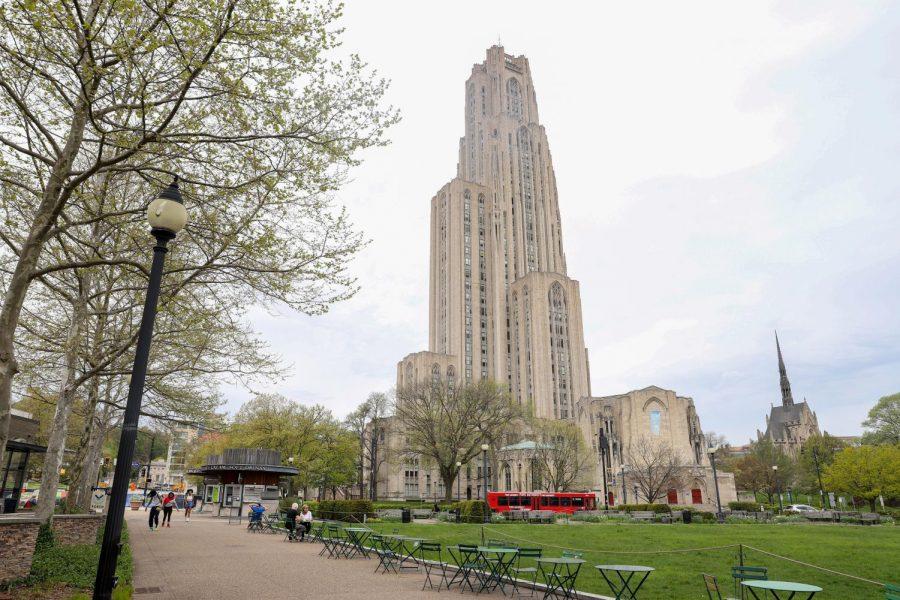Pitt enacts shelter in place, moves to Elevated posture after ‘significant’ increase in COVID-19 cases
Kaycee Orwig | Senior Staff Photographer
The Cathedral of Learning watches over an empty Pitt campus.
November 8, 2020
Pitt will move to the Elevated Risk posture and enact a shelter-in-place period three days earlier than previously scheduled at midnight Monday, according to a Sunday evening email from the University to students, faculty and staff.
Pitt said the move comes after a “significant” increase in COVID-19 cases — at least 40 since Friday alone — that it suspects comes from gatherings over Halloween weekend.
“This action is being taken to respond to a significant increase in positive cases among students over the weekend,” the email said. “There have been at least 40 confirmed cases since Friday, which we suspect are linked to gatherings that took place over the Halloween weekend.”
The Elevated Risk posture is the middle level of Pitt’s three-tiered reopening system. In this level, instruction is primarily virtual with minimal in-person learning, some shared spaces are open and gatherings are capped at 25 people. Campus dining will only be available through takeout beginning Monday morning. Residence hall lounges, recreation rooms and kitchens will begin closing Sunday night.
Allegheny County and Pitt’s Oakland campus have seen rising COVID-19 case numbers over the last several weeks. The county reported 288 new cases on Saturday, among the highest caseload in months, and the University had its second-highest report of new cases on Friday.
Data collected by The Pitt News. Original data collection by Ryan Yang, Online Visual Editor. Archival data by Spotlight PA and the Philadelphia Inquirer. Graph by Jon Moss, Editor-in-Chief.The shelter-in-place period will also begin three days earlier than previously scheduled by the University. During the shelter in place, students are allowed to leave their rooms or apartments to attend classes, labs or clinicals in person, pick up food, study in the library, go to work and shop “for essentials and medical needs.”
Pitt originally created the shelter-in-place period to “protect” students and their families and friends at home when they go home for Thanksgiving break, according to Dr. John Williams, the head of Pitt’s COVID-19 Medical Response Office.
Eric Macadangdang, the president of Student Government Board, said he was concerned about Pitt’s decision to originally move from Elevated to the lower Guarded Risk posture on Oct. 19, expressing worries about gatherings related to Halloween weekend, the election and the change to colder weather as possible sources of a rise in cases. Now, he said while the move back to Elevated is disappointing, it must be done to prevent more cases and protect students’ loved ones.
“Students want to go back home to see their families for Thanksgiving, the holidays,” Macadangdang said. “The best way to do that safely is to make sure that you are coming home without the virus. And the best way to make sure you do that is to shelter in place.”
Chris Bonneau, the president of the University Senate, described the current situation as a “perfect storm,” and wouldn’t be surprised if Pitt eventually moves to High Risk, the most severe of its three postures.
“That was the concern we had at the beginning — Halloween being on a weekend, the weather turning colder and we’ve seen a spike of cases in the community, as well,” Bonneau, a political science professor, said. “As well as we’ve been doing — we’ve said this from the beginning — we’re one bad night away from having an outbreak. That’s the thing with this virus — 95% compliance doesn’t really gun it.”
Bonneau added that he is concerned about mixed messaging about the shelter-in-place period and what students are permitted to do.
“When you have exceptions to a shelter-in-place, I think it causes confusion and I think even people who are trying to comply may inadvertently not comply because of that confusion,” Bonneau said. “If we’re asking students to shelter-in-place, I don’t see how that’s consistent with going to classes. It is true that we have not seen spread of COVID-19 in the classroom setting … but that’s not the concern. The concern is people being out and about, and if you’re going out to go to class, you’re probably going out to do some other things as well.”
Pitt spokesperson Kevin Zwick did not immediately respond to a request for comment about whether the University was concerned about sending mixed signals to students.



